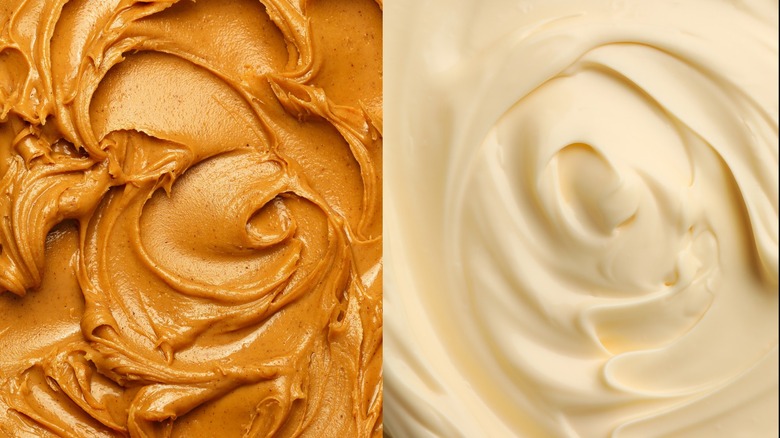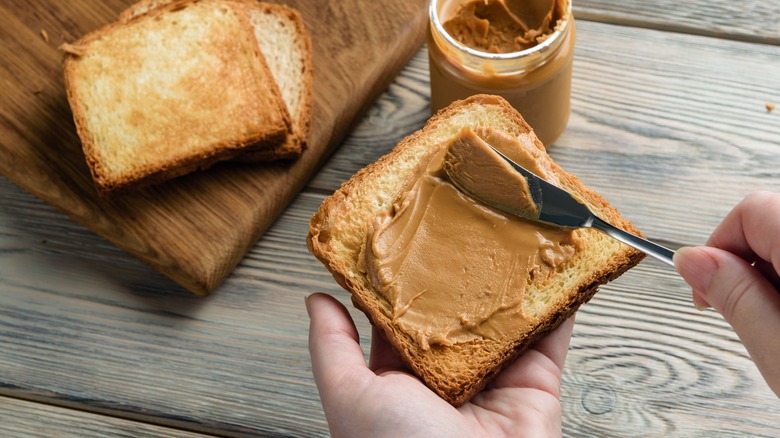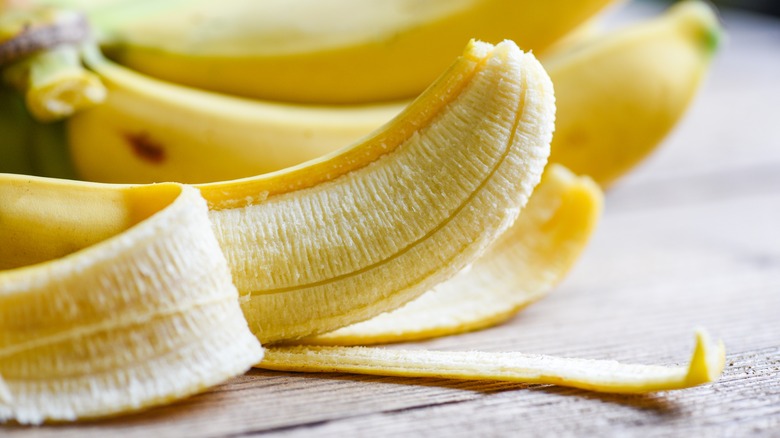The Peanut Butter Mayo Drug Scare That Shook The 1960s
Peanut butter and mayonnaise may sound like an odd combination, but in the mid-1900s, it was pretty popular. Peanut butter and mayo sandwiches — PB&Ms, if you will — initially rose to prominence during the Great Depression, particularly in the American South. Atlas Obscura suggests two reasons that this unlikely combo became a staple. First, combining protein-rich peanut butter and fatty mayonnaise created a calorie-dense meal for a fraction of the price of meat and dairy. Second, the peanut butter of the early 20th century was much coarser than we're accustomed to today; blending in some mayo improved spreadability.
PB&M remained popular well after the Depression passed. The combination pops up on social media now and then, but Garden & Gun explains that it peaked from the 1930s through the 1960s. In the '60s, Hellman's Mayo and Skippy Peanut Butter teamed up for an advertisement promoting different takes on the popular sandwich. These included the Double Crunch, supplementing the two spreads with bacon and pickles, and the Apple Fandango, which incorporated apples and marmalade. There was also the Crazy Combo, described in the ad as a "man-sized pleaser," which added salami, onions, and sliced eggs. And yet, these wacky sandwich combos weren't the weirdest use of peanut butter and mayo — not by a long shot. At the tail end of the 1960s, a rumor began to circulate, suggesting that the youth of America was getting high on PB&M.
Were '60s kids injecting themselves with sandwich fixings?
In the 1960s, a moral panic arose amongst older Americans about what their rebellious children were up to. Amid this panic, word began circulating that American kids were shooting up PB&M. A panicked headline appeared in the October 22, 1969 edition of The Fort Scott Tribune reading, "Peanut Butter, Mayonnaise Trips Fatal to Youngsters," citing Ernest Carabillo Jr. of the Federal Bureau of Narcotics who said that an underground cookbook containing "culinary escapes from reality" had been circulating among the youth. However, he did not provide concrete evidence of said cookbook or proof of this type of PB&M use.
Carabillo could not present proof because the whole thing was a hoax. This seems obvious when you consider the logistics of the story, so how did the panic begin? The Spotify podcast Food Crime suggests that the rumor came from a misinterpretation of slang terms. At the time, "peanut butter" was used in some circles to reference heroin, and "mayo" could refer to both heroin and cocaine. It seems that somebody took these terms literally. One person who fell for it was then-president Richard Nixon, who wrote in his public papers, "In certain regions, they are so crazy and insane as to inject into their bloodstream peanut butter, because somebody said that peanut butter gives you a high, and they die from that. Mayonnaise they are inserting into their bodies."
Food-related drug hoaxes are all too common
There have been many similar food-drug hoaxes over the years. JSTOR Daily recounts a tale from 1967 that began when a counterculture newspaper called the "Berkeley Barb" published a fake recipe for turning banana peels into a smokable paste. The rumor spread throughout the U.S. thanks to the burgeoning underground press. Atlas Obscura notes that, by complete coincidence, the Scottish singer Donovan released a song called "Mellow Yellow" in 1967, which many people interpreted as referring to the banana high. In 1970, the story was taken to the next level by William Powell, author of "The Anarchist's Cookbook," who claimed that bananas contained a psychedelic compound called bananadine, which, of course, doesn't exist.
Gullible folks have fallen for even crazier myths. Food Crime describes an Australian hoax that closely parallels the peanut butter and mayonnaise myth. As rumor had it, people were injecting themselves with vegemite – a salty, vegetable-like spread — which would be just as challenging to get through a syringe as peanut butter. Even in the 21st century, food-related drug hoaxes continue to sweep our society. In 2007, rumors that drug dealers were selling drugs to children in the form of a pop-rock candy called "strawberry quik," based on Nestlé Quik (via Snopes), caused panic. This, too, was false. So the next time you hear about someone who knows someone who was getting high on food, take it with a (non-hallucinogenic) grain of salt.


